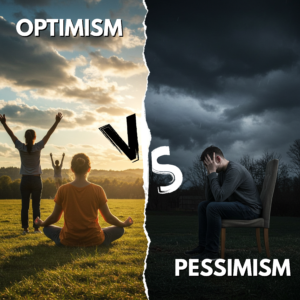Optimism and Pessimism are two mindsets that shape our perceptions, decisions, and reactions to life’s events. Often oversimplified in popular culture, these perspectives are frequently misunderstood. The term “optimist” is often associated with endless positivity, while “pessimist” is viewed as a synonym for negativity. However, these labels are not always accurate. In reality, both optimism and pessimism have nuanced effects on mental health, decision-making, and personal growth. By deconstructing these myths, we can gain a clearer understanding of how to harness both mindsets in a balanced and productive way.
1. Myth: Optimists Are Blind to Reality
One of the most common misconceptions about optimists is that they are detached from reality, viewing the world through rose-colored glasses. In truth, optimists acknowledge challenges and setbacks, but they maintain a hopeful outlook. They are realistic about difficulties but choose to believe that positive outcomes are possible, which empowers them to take proactive steps to overcome obstacles.
Studies in psychology show that optimism is not about denying difficulties but about believing that you can influence outcomes in your favor. For instance, optimists tend to have better coping strategies when facing adversity, as they focus on solutions rather than dwelling on problems.
2. Myth: Pessimists Are Always Negative and Unproductive
Pessimism is often seen as an inherently harmful and unproductive trait. While excessive pessimism can indeed be counterproductive, a certain level of pessimism, known as “defensive pessimism,” can actually improve performance in some situations. By anticipating potential obstacles, pessimists are more likely to plan thoroughly and avoid unforeseen risks.
According to psychologist Julie Norem, defensive pessimism allows individuals to manage anxiety and prepare for worst-case scenarios. This strategy can result in better outcomes in high-stakes environments like academic testing or important business presentations, where careful preparation and risk avoidance are key.
3. Myth: Optimism Equals Happiness
While optimism is often linked with happiness, the two are not always synonymous. Optimism is about a mindset that anticipates positive outcomes, but happiness is an emotional state that may or may not follow. In fact, some optimists may feel disappointed when things don’t turn out as expected, leading to frustration. Happiness is influenced by a variety of factors, including personal values, relationships, and life circumstances.
Studies on well-being indicate that happiness is often a result of how we align our values with our actions, not simply by having an optimistic outlook. For instance, people who focus on intrinsic goals (like personal growth or relationships) tend to be happier, regardless of their level of optimism.
4. Myth: Pessimists Are Always Depressed
While pessimism can be linked to depression in some cases, not all pessimists suffer from mental health issues. In fact, some pessimistic individuals can lead fulfilling, balanced lives. The distinction lies in how they manage their pessimism. Pessimism that leads to rumination or hopelessness may contribute to depression, but pessimism that is used constructively for planning and risk assessment can prevent negative outcomes without leading to mental health concerns.
Cognitive Behavioral Therapy (CBT) often teaches individuals to reframe negative thinking patterns. It’s not about eliminating pessimism entirely but learning how to channel it productively to reduce stress and anxiety, which helps prevent depression.
5. Myth: Optimists Don’t Experience Negative Emotions
Optimists do experience negative emotions, but they tend to bounce back more quickly from them. The idea that optimists are always cheerful is a myth. They experience sadness, frustration, and anger just like anyone else. However, their hopeful outlook allows them to process and recover from negative emotions faster than pessimists.
According to a study published in the Journal of Personality and Social Psychology, optimists tend to have better emotional regulation, which enables them to experience and move past negative emotions with greater resilience.
6. Myth: Pessimism Is a Sign of Intelligence
While pessimism is often associated with being more “realistic” or “intelligent,” this view is oversimplified. Intelligence isn’t about focusing on the worst-case scenario but rather about understanding the complexities of a situation and thinking critically. Pessimism, when excessive, can lead to overthinking and decision paralysis, which can be counterproductive.
A study conducted by the University of Melbourne found that individuals who focus too much on potential risks (a common trait among pessimists) often struggle to make decisions, as they become overwhelmed by fear of failure. Optimism, on the other hand, promotes greater decision-making confidence and creativity.
7. Myth: Pessimism is Contagious
While negative thinking can influence others, especially in close relationships or work environments, pessimism is not inherently contagious. The emotional climate of a group can indeed be affected by an individual’s attitude, but people are capable of maintaining their own emotional resilience. Positive interactions and constructive communication can mitigate the impact of pessimistic viewpoints.
Social psychology suggests that emotional contagion, or the spread of emotions among groups, is real. However, the spread of emotions can be influenced by the collective mindset of the group, and individuals who are equipped with emotional intelligence can counterbalance negativity.
8. Myth: Optimism Is Inherited, and You Can’t Change It
While genetics may play a role in predisposition toward optimism or pessimism, mindset is also shaped by environment, experiences, and intentional efforts. It’s possible to cultivate a more optimistic outlook through practices like gratitude, reframing negative thoughts, and setting positive goals. In fact, optimism is considered a “learnable” skill that can be nurtured with consistent effort.
A study published in Psychological Science found that optimism can be enhanced through interventions like positive affirmations and mindfulness, demonstrating that even those predisposed to pessimism can train themselves to be more optimistic.
9. Myth: Optimists Ignore Risk and Take Foolish Chances
Optimists do not ignore risks; they simply approach them with a belief that they can manage and overcome potential obstacles. The key distinction between an optimist and a reckless individual is the ability to assess risks while maintaining hope. In fact, many successful optimists take calculated risks, backed by preparation and planning.
The Journal of Personality and Social Psychology highlights that optimists tend to weigh risks and benefits more carefully. Their optimistic mindset helps them take necessary risks with the understanding that they can overcome challenges, unlike individuals with a purely pessimistic outlook who may shy away from taking any risk at all.
10. Myth: Pessimism Is Always a Choice
While we can choose how we respond to certain situations, pessimism is not always within a person’s immediate control. Mental health conditions such as anxiety and depression can make it difficult to break free from negative thought patterns. In these cases, pessimism is not a simple choice, but rather a symptom of underlying struggles that require professional support and intervention.
Mental health professionals emphasize that while cognitive strategies can help individuals manage pessimism, the root causes of persistent negative thinking may lie in deeper psychological issues that require therapeutic support.
Conclusion: Embracing a Balanced Approach
Both optimism and pessimism come with their own sets of strengths and challenges. By recognizing the myths surrounding these mindsets, we can better understand how they influence our thoughts, behaviors, and emotions. The key lies in finding a balance between the two — adopting an optimistic perspective that allows us to see opportunities and solutions while acknowledging and preparing for potential setbacks. Cultivating this balanced mindset can empower us to live more resilient, fulfilling lives.


